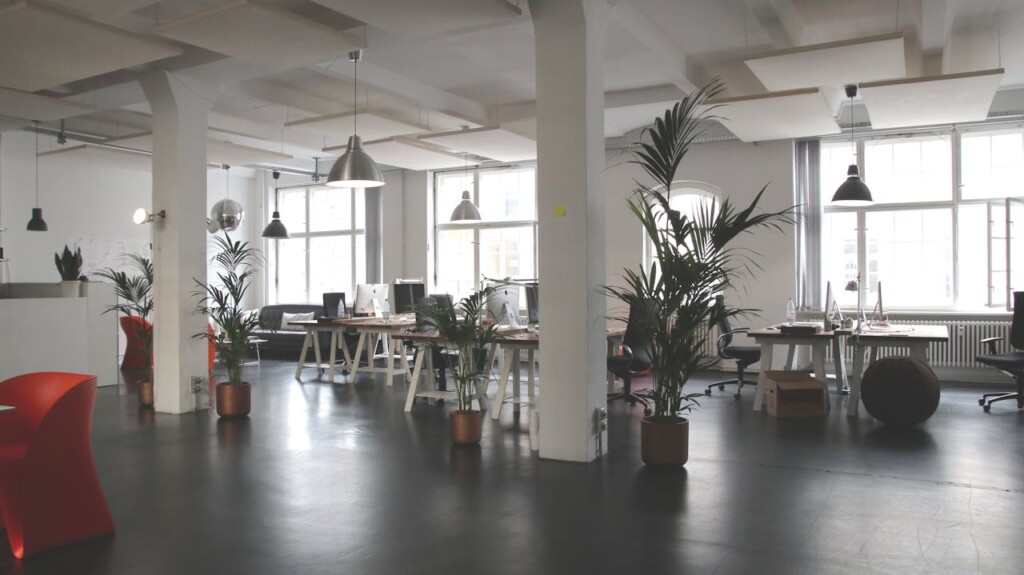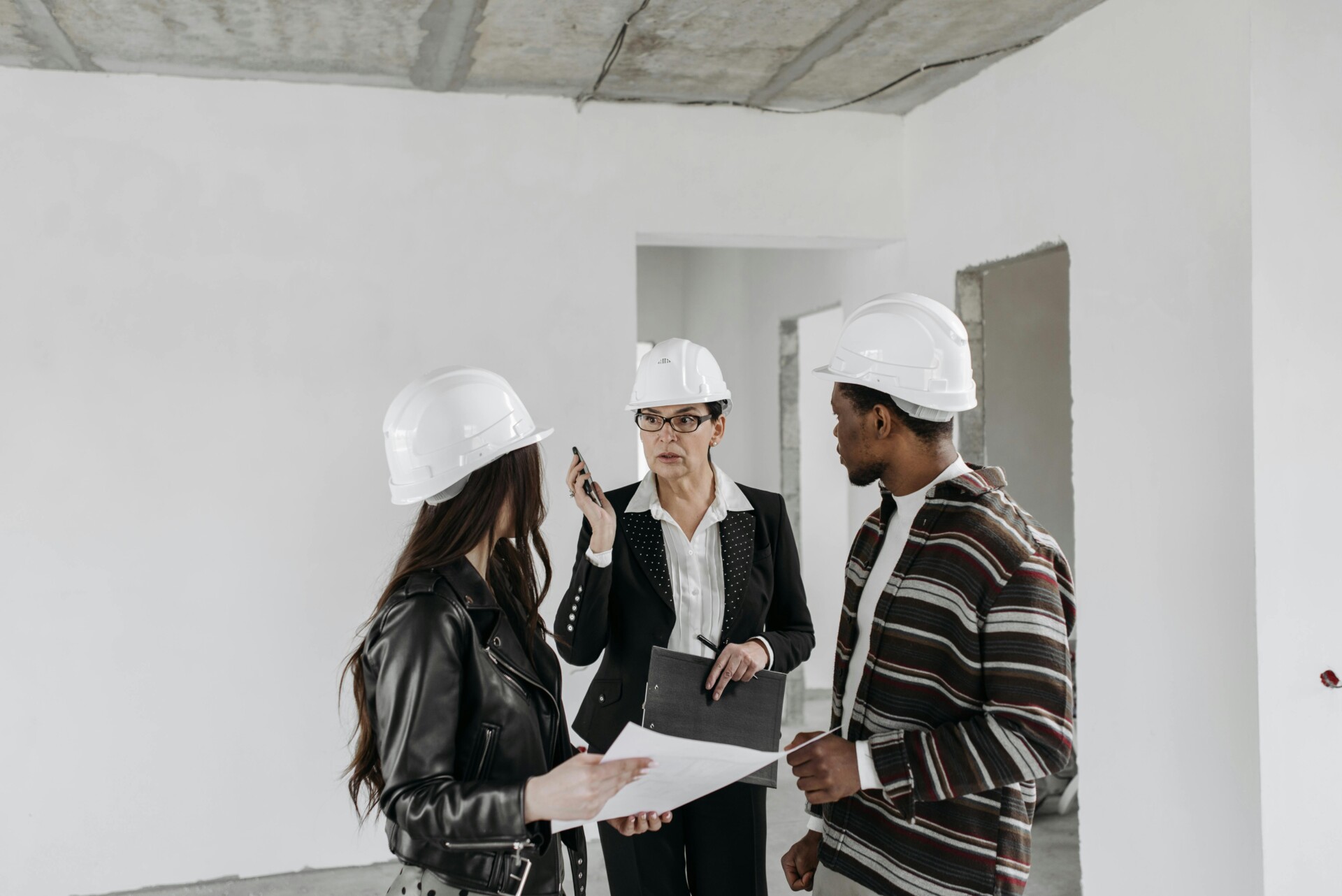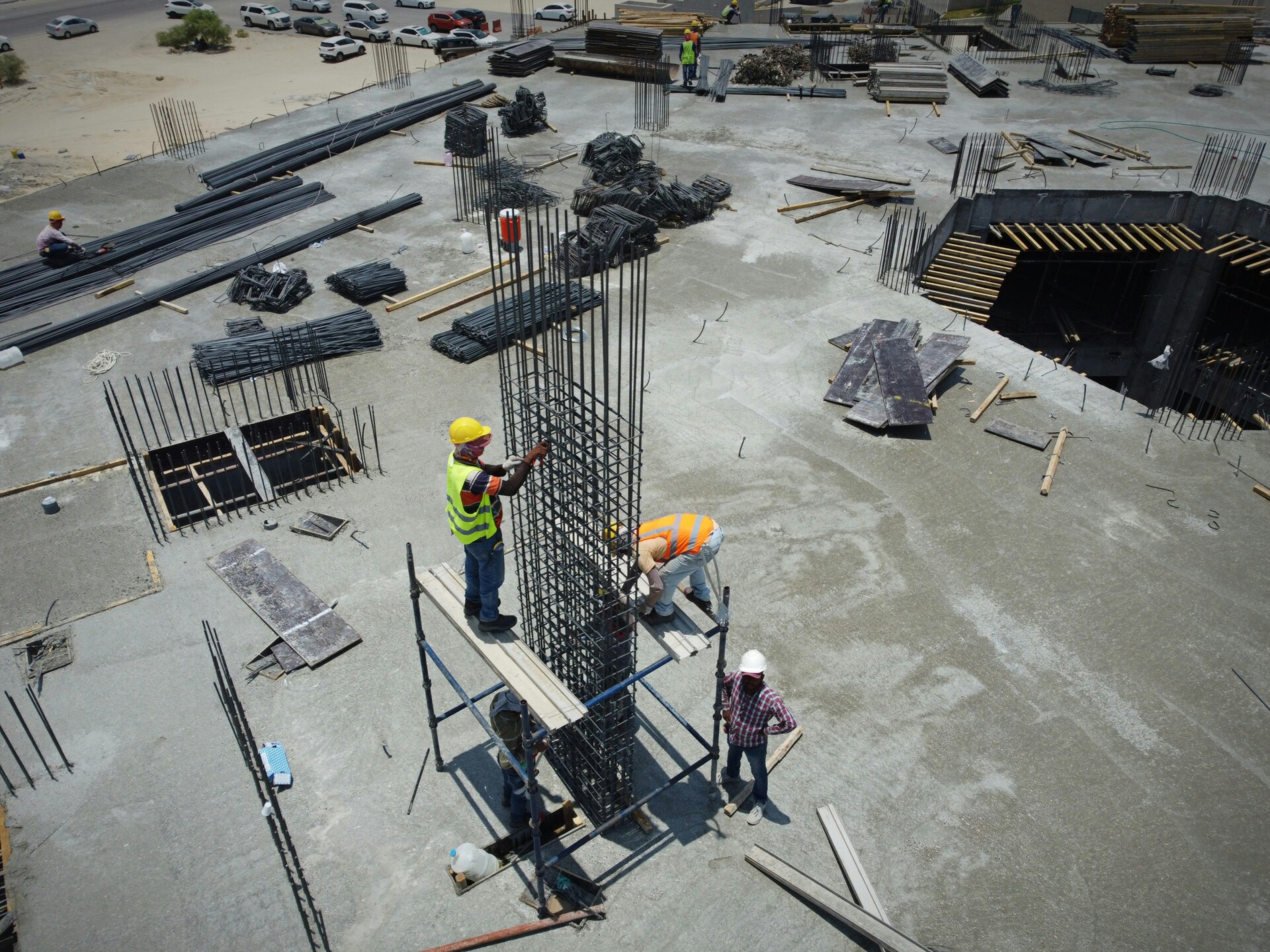Steel prices reached $912 per ton in February 2025, up from $950 per ton in March 2022, while lumber tariffs continue to pressure material costs. These factors directly impact office building cost per square foot across the United States.
In 2025, national office building cost ranges vary significantly by building height. Single-story offices typically cost $240 to $440 per square foot, while mid-rise offices range from $330 to $870 per square foot, and high-rise offices command $430 to $1,000 or more per square foot. Location, design complexity, and finish level determine where each project falls within these construction budgeting ranges.
How Do Office Building Costs Change By Building Height?

Height drives significant cost differences in office construction. As we add floors, structural systems become more complex, elevator requirements multiply, and life-safety systems expand to meet code demands.
Single-Story Office Buildings
Single-story offices represent the most economical option, typically ranging from $240 to $440 per square foot. These buildings rely on lighter structural frameworks and avoid elevator installations entirely. The simpler mechanical systems and straightforward fire egress paths keep costs at the lower end of office construction ranges.
We see costs toward the higher end when single-story projects incorporate premium facades, extensive glazing, or high-end interior specifications. Corporate headquarters and Class A facilities often push into the upper portion of this range.
Mid-Rise Office Construction
Mid-rise buildings, generally spanning 5 to 10 stories, jump to $330 to $870 per square foot. The structural systems require heavier steel or concrete framing to handle increased loads. Elevator systems become essential, typically requiring at least two cars to meet building codes and provide adequate service.
Life-safety systems expand significantly in mid-rise construction. We coordinate fire alarm networks, sprinkler systems throughout multiple floors, and emergency lighting that meets egress requirements. These buildings also demand more sophisticated HVAC systems to maintain comfort across multiple zones.
High-Rise Office Complexities
High-rise offices over 10 stories command $430 to $1,000+ per square foot due to engineering complexities. Structural systems require robust steel or reinforced concrete to resist wind loads and seismic forces. Foundation systems often extend deep into bedrock or require specialized pile systems.
Elevator requirements multiply in high-rise construction. Buildings typically need multiple elevator banks, express elevators for upper floors, and dedicated freight elevators. We coordinate complex elevator machine rooms and ensure adequate lobby space for efficient passenger flow.
Life-safety systems become highly sophisticated in tall buildings. Fire pumps boost water pressure to upper floors, emergency generators power critical systems during outages, and stairwell pressurization systems prevent smoke infiltration. These systems require dedicated mechanical spaces that reduce rentable area.
Premium Features And Cost Escalation
Higher-end facades and interiors push costs toward the top of each height category. Curtain wall systems, architectural glazing, and premium stone or metal cladding can add $50 to $150 per square foot. Interior specifications for Class A space include raised flooring systems, sophisticated lighting controls, and premium finishes that significantly impact totals.
We coordinate these premium elements early in design to manage their cost impact while achieving the desired aesthetic and functional goals.
Where Are Office Building Costs Highest And Lowest In The U.S.?
Regional variations in office construction costs reflect fundamental differences in labor markets, regulatory environments, and logistical challenges. We see substantial cost spreads across the four major regions, with geographic factors creating price differences that can impact project feasibility and site selection decisions.
Eastern Region Premium Markets
The Eastern region commands some of the highest office building costs nationally. Single-story offices range from $301 to $361 per square foot, while mid-rise projects cost $599 to $719 per square foot. High-rise construction reaches $688 to $827 per square foot, reflecting the premium associated with dense urban markets.
Dense metropolitan areas like New York City, Boston, and Washington D.C. drive these elevated costs through multiple factors. Union labor requirements increase wage rates substantially above national averages, while stringent building codes demand additional compliance measures and specialized systems. Limited site access and complex logistics in established urban cores add operational challenges that translate directly to higher construction costs.
Western States And Seismic Considerations
Western markets show single-story office costs of $313 to $378 per square foot, with mid-rise buildings ranging from $481 to $607 per square foot. High-rise projects cost $557 to $730 per square foot, positioning the West as a high-cost region but generally below Eastern levels for comparable structures.
Seismic design requirements significantly influence Western construction costs, particularly in California markets. These specialized structural systems, enhanced foundation work, and additional safety features add complexity and expense to projects. Coastal cities like San Francisco and Los Angeles face additional cost pressures from environmental regulations and skilled labor shortages that further elevate regional benchmarks.
Midwest Cost Advantages
The Midwest consistently offers the most cost-effective office construction environment. Single-story buildings cost $237 to $298 per square foot, while mid-rise structures range from $454 to $556 per square foot. High-rise projects cost $554 to $689 per square foot, representing significant savings compared to coastal regions.
Lower labor rates and reduced regulatory complexity contribute to these regional advantages. Material transportation benefits from the region’s central location and established manufacturing base, reducing logistics costs. However, seasonal construction limitations and weather-related delays can impact project schedules in northern Midwest markets.
Southern Region Competitive Positioning
Southern states demonstrate competitive office construction costs with single-story buildings at $238 to $286 per square foot. Mid-rise projects range from $474 to $569 per square foot, while high-rise construction costs $545 to $654 per square foot, positioning the South as a cost-effective alternative to coastal markets.
Favorable labor costs and extended construction seasons contribute to Southern cost advantages. States like Texas and Florida benefit from business-friendly regulatory environments and growing construction capacity. However, rapid population growth in major Southern metropolitan areas has begun pressuring costs upward, though they remain below Eastern and Western levels.
Regional Cost Drivers And Market Dynamics
Geographic cost variations stem from fundamental differences in regional construction markets. Urban density creates logistical challenges and drives up land values, labor costs, and material delivery expenses in Eastern and Western markets. Seismic codes on the West Coast require specialized engineering and enhanced structural systems that add measurable cost premiums to projects.
Labor market conditions vary substantially by region, with unionized markets generally commanding higher wage rates. Material availability and transportation costs also influence regional benchmarks, as proximity to manufacturing centers and transportation infrastructure affects project economics. We coordinate with local suppliers and subcontractors to optimize material logistics and leverage regional advantages when possible.
Which Factors Drive Office Building Cost The Most?

Multiple interconnected factors influence office building construction costs, with material prices and labor rates creating the foundation for project budgets. Understanding these cost drivers helps us develop accurate estimates and manage project expenses effectively throughout the construction process.
Material Cost Fluctuations
Steel, lumber, concrete, and asphalt represent the primary material cost drivers in office construction. Steel prices increased 15-25% in 2024, while lumber jumped 17.2% year-over-year according to current market data. These fluctuations stem from supply chain disruptions, tariffs on imports, and persistent inflation affecting global commodity markets.
Concrete prices remain volatile due to cement availability and transportation costs. We track these material indices closely since they directly impact our project budgets and require ongoing adjustment throughout the construction timeline.
Labor Rate Pressures
Skilled labor shortages continue driving wage increases across all construction trades. Current 2024-2025 hourly rates show architects commanding $100-$250 per hour, while structural engineers range from $100-$220 per hour. General contractors typically charge $50-$150 per hour for their services.
Specialized trades reflect similar upward pressure. Electricians now cost $50-$130 per hour, and plumbers range from $45-$150 per hour depending on market conditions and project complexity. These rates vary significantly by region, with urban markets commanding premium pricing.
Geographic Location Impact
Urban and coastal areas add substantial costs through higher wages and complex logistics. Dense metropolitan environments require specialized equipment, restricted working hours, and premium labor rates that can increase total project costs by 20-30% compared to suburban locations.
Transportation and site access challenges in urban markets drive up material delivery costs. We factor these logistical considerations into our estimates, as they materially affect both timeline and budget requirements.
Economic Conditions And Financing
Inflation and interest rates directly influence construction bids and project financing. Current Federal Reserve rates at 4.25-4.50% create carrying costs that add 2-5% to total project budgets through construction loans and extended development timelines.
Market volatility affects material procurement strategies and subcontractor pricing. We monitor economic indicators closely to anticipate cost shifts and adjust our bidding accordingly.
Regulatory Compliance Costs
Building codes and permit requirements add both time and expense to office projects. Complex urban jurisdictions often require extensive plan reviews, specialized compliance measures, and coordination with multiple agencies that can extend schedules by several months.
Environmental regulations, seismic requirements, and accessibility standards create additional engineering and material costs. These regulatory factors vary significantly by location but consistently impact project budgets across all building types.
Building Quality And Finish Specifications
Class A office specifications demand premium materials and systems that significantly increase per-square-foot costs. Interior finishes represent a substantial portion of total project expenses, often accounting for 25-30% of construction budgets in high-end developments.
Premium lobbies, high-end elevator systems, and sophisticated lighting controls drive costs toward the upper ranges of market pricing. We work with clients to balance finish quality with budget constraints through value engineering approaches.
Building Systems Integration
HVAC, electrical, and plumbing systems create significant cost components in office construction. Current market data shows HVAC systems costing approximately $20-$28 per square foot in typical office builds, while plumbing ranges from $4-$6 per square foot.
Electrical systems vary widely based on technology requirements, ranging from $2-$15 per square foot depending on power distribution complexity and specialized equipment needs. Modern office buildings require sophisticated data infrastructure that adds to electrical system costs.
Site Preparation And Design Complexity
Foundation requirements and site preparation work create substantial cost variations between projects. Challenging soil conditions, contaminated sites, or complex urban environments can double excavation and foundation costs compared to standard conditions.
Architectural complexity affects both design fees and construction costs. Buildings with unique geometries, complex facades, or specialized structural systems require additional engineering and coordination that increases total project expenses significantly.
How Can Teams Estimate And Control Office Building Cost?
Successful cost estimating requires systematic processes that evolve from early site assessment through project completion. We approach office building cost control through structured methods that address the variables established in previous discussions while maintaining accuracy throughout the project lifecycle.
Early Site Assessment And Scope Definition
Site assessment forms the foundation of accurate cost estimating. We conduct thorough evaluations that examine soil conditions, existing utilities, access limitations, and environmental factors that directly impact construction costs. These assessments reveal potential complications before they affect budgets or schedules.
Scope alignment proves equally critical in the early phases. We work with project teams to match building class specifications with available budgets, ensuring that Class A finishes align with premium budgets while Class B or C specifications support more conservative cost targets. This alignment prevents scope creep and maintains realistic expectations throughout the estimating process.
Technology Integration For Accurate Estimating
Modern estimating software provides the precision required for complex office building projects. We utilize platforms that integrate current labor rates and material pricing indices, allowing real-time adjustments as market conditions shift. Construction estimating software eliminates manual calculation errors while maintaining detailed databases of historical costs and productivity rates.
These systems enable rapid scenario analysis when evaluating different design options or material selections. We can quickly model cost impacts of structural system changes, facade selections, or interior finish upgrades to support informed decision-making during the design development phase.
Risk Management Through Contingency Planning
Contingency allocation requires careful consideration of project-specific risk factors. We typically carry contingencies between 10% and 20% of total project costs, with the exact percentage determined by project complexity, site conditions, and design completeness. Higher contingencies apply to projects with challenging sites or compressed schedules.
Market trend tracking supports both contingency planning and cost control efforts. We monitor material price fluctuations, labor rate increases, and financing conditions that could affect project costs. This monitoring enables proactive adjustments to estimates and helps teams prepare for potential cost pressures before they materialize.
Value Engineering And Procurement Strategies
Value engineering provides opportunities to optimize costs without compromising project quality. We evaluate alternative materials, construction methods, and system selections that can reduce costs while meeting performance requirements. These evaluations often identify more cost-effective solutions that deliver equivalent functionality.
Bulk purchasing strategies and early procurement commitments can secure favorable pricing for major material categories. We coordinate with suppliers to lock in pricing for steel, concrete, and other materials subject to market volatility, providing budget certainty throughout the construction phase.
Alternative Delivery Methods For Cost Control
Design-build delivery streamlines decision-making processes that can impact costs and schedules. This method enables real-time cost feedback during design development, allowing teams to make informed adjustments before finalizing construction documents. The integrated approach reduces change orders and maintains better cost control throughout the project.
Prefabrication and modular construction offer significant opportunities for cost reduction and schedule compression. These methods can reduce total project schedules by up to 50% while cutting costs by approximately 20% through improved quality control and reduced field labor requirements. We evaluate prefabrication opportunities early in the design process to maximize these benefits.
Permit planning requires early attention to avoid costly delays during construction. We coordinate with local jurisdictions to understand review timelines, fee structures, and compliance requirements that affect both costs and schedules. Early permit applications and proactive code compliance reviews prevent delays that can significantly impact project budgets.
Conclusion: Plan Your Office Building Cost With Confidence

Understanding office building costs allows us to approach projects with realistic expectations and strategic planning. The core benchmarks remain consistent: single-story offices typically range from $240 to $440 per square foot, mid-rise buildings fall between $330 and $870 per square foot, and high-rise construction starts at $430 and can exceed $1,000 per square foot. These ranges shift based on regional factors, with the Midwest offering the most cost-effective markets and coastal areas commanding premium pricing.
Effective cost control starts with early scope definition and comprehensive site assessment. We use current labor and material indices to create accurate estimates, then apply a 10% to 20% contingency to account for market volatility and unforeseen conditions. Value engineering, bulk purchasing strategies, and prefabrication methods can reduce both costs and schedules significantly. Design-build delivery streamlines decision-making and reduces coordination risks that often drive up final project totals.
Contact EB3 Construction to discuss your office building project and receive expert guidance on cost planning and construction strategies.




